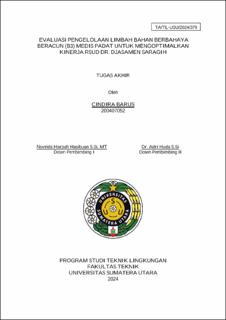| dc.description.abstract | RSUD Dr. Djasamen Saragih Pematang Siantar, in providing health services, also plays a direct role in producing solid medical B3 waste of approximately ±80 kg/day, and within a month it can reach ±1500 kg. The management of solid medical B3 waste in hospitals is still not carried out well, so it is necessary to evaluate the stages of solid medical B3 waste management, which include sorting, containing, storing, and processing the waste. The purpose of this study is to examine the origins, traits, and production of solid medical B3 waste. Aside from that, this study will examine the current state of RSUD Dr. Djasamen Saragih Pematang Siantar City's solid medical B3 waste management, which comprises sorting, containerization, storage, and processing. Additionally, this study aims to assess solid medical B3 waste management by contrasting it with Minister of Environment and Forestry Regulation Number 56 of 2015. Using open-ended interview questionnaires, documentation, and supporting data acquired from the hospital, the research methodology used to assess the management of B3 waste is qualitative and includes descriptive research on the research object, namely sources, characteristics, and generation, as well as stages of management of solid medical B3 waste. The acquired data will be reduced, compared, and identified throughout processing before undergoing a thorough evaluation. According to the research's findings, several B3 waste management requirements outlined in Minister of Environment and Forestry Regulation No. 56 of 2015 have not yet been implemented, making the management of B3 solid medical waste at RSUD Dr. Djasamen Saragih Pematang Siantar City inappropriate. The conclusion drawn is that in order to maximize the effectiveness of solid medical B3 waste management, efforts must be made to sort B3 waste according to its type, group, and characteristics at the point of production; install suitable drainage around the B3 waste TPS; clean the B3 waste TPS daily; store B3 waste in accordance with the designated time; and ensure that the efficiency of burning B3 waste complies with applicable regulations, specifically 99.95% | en_US |


